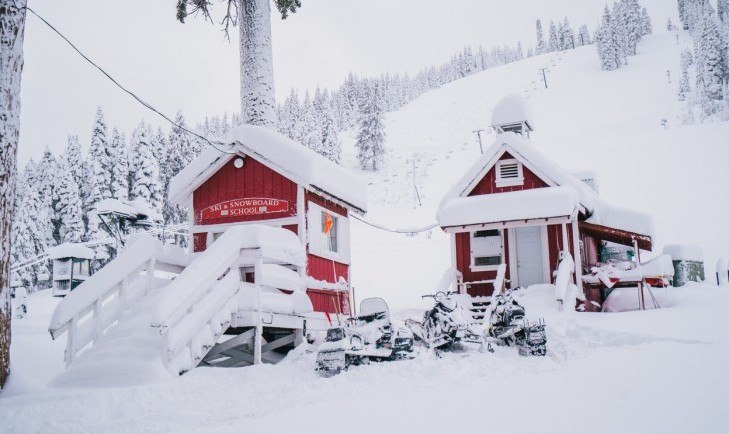
The Western Governors' Association keeps you updated on the latest news in the West. Here are the top stories for the week starting Dec. 13, 2021. (Photos courtesy of Homewood and K.M. Cannon)
After a historically dry fall, winter finally returned to the West this week as an atmospheric river moved in from the Gulf of Alaska and provided much-needed moisture to the region – including several feet of snow in mountain communities. This will be "easily the biggest snowstorm this season," forecasters at the National Weather Service said.
Several western cities, including Boise, Denver, Salt Lake City and Portland received their first measurable snowfall of the season. Even San Diego got some flurries. At higher elevations, the snow allowed several ski areas to open more terrain, just in time for the holiday tourist season. Tamarack Ski Resort in Idaho racked up 30 inches. Over 2 feet of snow hit Lake Tahoe, California and the National Weather Service predicted as much as 8 feet of snow could blanket the area by the end of the storm cycle. Utah also received over a foot of snow. As the storm continues to move East, the National Weather Service predicted double-digit snow totals in Colorado with up to 2 feet expected in the San Juan Mountains. Much like those in California, Colorado ski resorts are hoping the storm can help them overcome delayed openings.
While the storm has many excited for the start of ski season, others are focused on the region’s snowpack. Though this specific storm cycle only slightly reduced drought conditions, water managers are hopeful that it’s the start of a much snowier winter thanks to La Nina, which can often create above-average amounts of precipitation. With more rain and snow on the way in the next two weeks, water managers in California believe the drought needle should move in a positive direction this month. “The difference between a wet year and some of the wettest years on record and some of the driest years on record, is just a few storms,” said Jay Lund who heads the UC Davis Center for Watershed Sciences. Weather experts in North Dakota are also predicting a snowier winter for the central and western parts of the state, as are forecasters in Wyoming who say the state is on pace for an average snowpack.
WOOD POWER: Mote, a California-based company announced the development of a facility to convert wood waste into hydrogen fuel while capturing, utilizing, and sequestering CO2 emissions from the process. Using more than 500 million metric tons of wood and agricultural waste that is generated every year in the U.S., Mote expects to produce approximately seven million kilograms of carbon-negative hydrogen and remove 150,000 metric tons of CO2 from the air annually by working with CarbonCure Technologies to store its CO2 in concrete. Learn more about strategies for reusing wood and agricultural waste from various land management projects in WGA’s Working Lands, Working Communities Initiative.
MENTAL HEALTH HELP: Using RNA for as an effective biomarker to decipher an individual’s genomic base, CircGenomics, a startup developed at the University of New Mexico, is working to advance technology that diagnoses neurological disorders like depression and post-traumatic stress disorder and allows physicians to immediately determine the best treatment for patients. Currently, an average of 40% of patients respond to the first anti-depressant prescribed, and often it takes months to see if it works. “If we can increase the first-time success from 40% to, say, 60%, we’re talking about millions more people who will get something effective on just their first visit to the doctor. That’s huge,” Nikolaos Mellios, an assistant professor in the UNM Neurosciences Department who helped develop the technology, said.
RENEWABLE UTAH: When an 80-megawatt solar farm is completed in 2023, almost all of the electricity used by Salt Lake City’s government will be generated by renewable means. Developed by D.E. Shaw Renewable Investments (DESRI), the solar farm will run energy through Rocky Mountain Power to Salt Lake City as well as Park City, Summit County, Utah Valley University, Deer Valley Resort and Park City Mountain. The project was made possible by legislation passed in 2019 that provides a framework for municipalities to work with utilities to develop renewable energy sources.
 REAL GENIUS: Jack Rico, a 15-year-old “major history buff” from Huntington Beach, California will earn a bachelor’s degree with honors from the University of Nevada Las Vegas, possibly making him the youngest student to graduate from the school in its 57-year history. After demonstrating a high level of intelligence in middle school, Rico began taking college classes at Fullerton College when he was 11. In the spring of 2020, he graduated with four associate degrees — in history; social sciences; social behavior and self-development; and art and human expression — and a perfect 4.0 GPA. Now, he’s graduating with a 3.78 grade-point average and a degree in history.
REAL GENIUS: Jack Rico, a 15-year-old “major history buff” from Huntington Beach, California will earn a bachelor’s degree with honors from the University of Nevada Las Vegas, possibly making him the youngest student to graduate from the school in its 57-year history. After demonstrating a high level of intelligence in middle school, Rico began taking college classes at Fullerton College when he was 11. In the spring of 2020, he graduated with four associate degrees — in history; social sciences; social behavior and self-development; and art and human expression — and a perfect 4.0 GPA. Now, he’s graduating with a 3.78 grade-point average and a degree in history.
Get the latest news about the West and its governors by following the Western Governors' Association on Twitter, Facebook and LinkedIn.
Check out our podcast, Out West, on Podbean, Spotify and Apple Podcasts